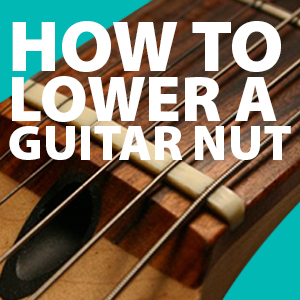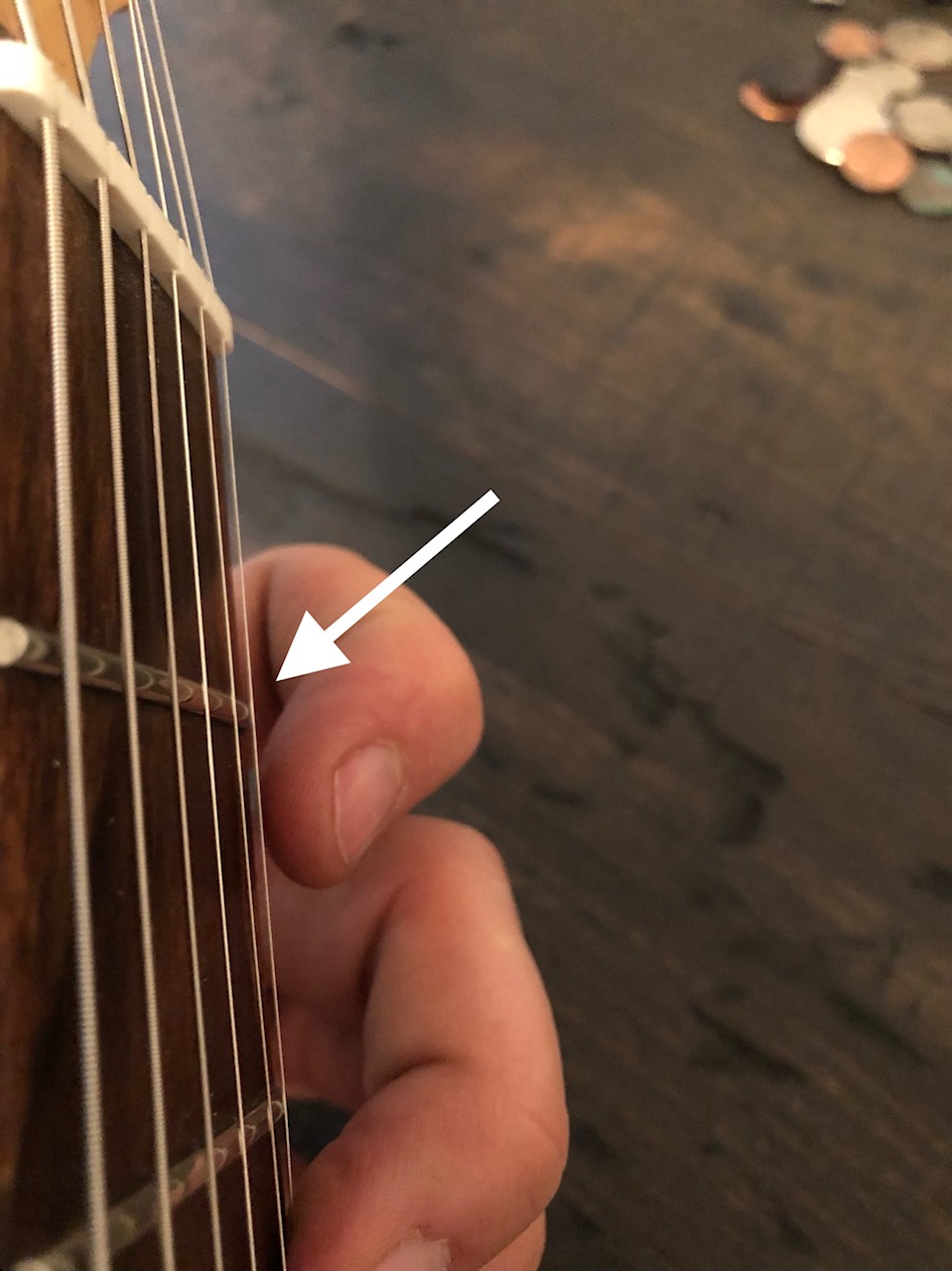Proper Nut Slot Height

String height is adjusted by filing the nut slots until the strings are at the proper height. I check string height by measuring the distance between the top of the first fret and the bottom of the string using a feeler gauge. I shoot for twelve thousandths (0.012) of an inch clearance under the G and D, and ten thousandths (0.010) under the A. As long as your frets are leveled you can set the nut height. File the nut slot or sand the bottom of the nut to get the proper height. To check that the nut slot is at the proper depth fret the string at the 3rd fret. There should be just a hair of clearance between the string and 1st fret. To measure the height of the strings at the nut, measure from the top of the first fret to the bottom of the string. We then will use the proper nut files for the string gauges used to. Low E and A should measure 2/64' (cm. 0,0793), D and G =1.5/64' (cm.0,0595) and B and high E = 1/64' (cm. If string height at nut is correct, recheck string height at 12th fret with strings open. Measurement for low and high E's should be the same as measurement taken at the 15th.
Nut slots...with principles that apply, as appropriate, to bridge slots as well
Here's a gnat's-eye view at the face of a nut as seen from the leeward side of the second fret. The slots for these two strings are cut so that they completely support the string.
The sketch above relates to fretted instruments, but the basic principles are no different for violin family and other unfretted instruments. I'll try to explain the clearance in a minute.
Here's an idea of how it works on a bass:
Having the slot cut too high above the frets (or an unfretted board of some type) means that the act of pressing the string down to the first few frets actually stretches the string, raising the pitch and throwing the intonation off in the process. Ideally, the nut slot height is identical to any other fret. But remember that strings can 'saw' themselves through a nut just through normal use. I ordinarily leave a nut slot a little higher than necessary at first, to allow for the string to cut itself a little lower. I also avoid synthetic and elephant ivory, both of which are too soft and rubbery to make good nuts for steel strings.
Here's a shimmed-up mess of a nut that has all the problems:
These slots are all too deep, but the B is still so high it doesn't play in tune, so someone shoved a piece of ebony under it to try and correct the intonation. Big 'Ugh' for this one.
People often comment on certain strings (e.g., mandolin A strings, guitar G strings) being more troublesome, always seeming to go out of tune during play. Mandolin A's are always the most troublesome because they have to make compound bends from the nut: back as well as to one side. And the length from the nut to the post being the other important factor. And being plain strings, they tend to bind if the slots aren't cut right. (The D's, being wound, tend to refine their own slots.)
When you tune, you always tune up to a note, never down, right? Right.
It's about friction in the slot.
And with a poorly cut nut, when you tune up, the tension on the length of string between the nut and the string post is greater (per unit of length) than the part you actually play, that's between the nut and the bridge. After getting the pitch just right, a bit of actual playing works the string, making the tension on both sides of the nut equalize, and voilà: you're out of tune in mid-phrase. It has nothing to do with the tuning machines, which people just love to blame, but everything to do with setup, particularly how precisely the string slots at the nut are cut.
A quick word about creaking guitar G strings: this issue is fading as elephant ivory nuts are fading. Bone is superior to ivory for a nut material because it's harder and burnishes better. Ivory is soft and actually registers the imprint of string windings. That irritating creak is the sound of the windings skidding over grooves impressed inside the nut slot. Once again: setup is everything. (You can resurface string slots in an ivory nut by inlaying bits of with pearl or bone, if you like.)
How do you easily determine the ideal height of the string slot in the nut? OK, start with ⓵:
The string is a superb straightedge when it's under tension. This assumes the frets are really true and level.

The sketch below illustrates how - and how not - to shape a slot for any string.
Left: like the messy nut above, the nut material is too high. You need only enough to support half the diameter of the string. Anything more is just in the way. When the string is way below the top of the nut, you have great difficulty telling whether it's seating properly.
Next: a slot that's cut with a saw has a roughly flat bottom and also affords poor acoustic coupling. Saws seldom match the precise width of the string, which can roll side to side in the slot.
Next: strings will work their way down a v-cut, often bottoming out on frets (or the board, as the case may be with fretless instruments). The signal transfer is compromised because of the limited contact, and the string sizzles on the fret or the board. They also tend to bind and squeak. They can ruin your day.
Right: the slot really fits the diameter of the string, the nut material does not go above the halfway point of that diameter, and leaves the string a trace of clearance above the fret or the unfretted board surface.
How much is a trace? I'm reluctant to assign a measurement—it's very little. You can still see a bit of light.
If you hold any string down on any fret of a well set up instrument, you'll see that same preferred clearance at the next fret up.
Before going further, here's how to correct a string slot that's too low. Often it's wiser to repair a blown slot than it is to replace the whole nut.
Quick fixes like some kind of dust (bone, acrylic, baking soda) with superglue are really temporary. It takes little more effort to implant a little patch of bone (or even pearl) into the nut and recut the slot. It's as good as the original, and if done well, is quite invisible.
I have a couple of saws I use for widening and deepening in preparation for an implant. One is a fine hacksaw blade in a short handle, which is for wider strings. It leaves a nice flat-bottomed slot. The other is a backsaw such as one would use for cutting fret slots, which does the same and is good for finer strings. Avoiding hitting the first fret, assuming there is one, I cut down below the blown slot, sometimes almost to the board itself, angling the saw back a bit. Then I prepare the piece of bone (or whatever: ebony for a violin or cello) by carefully filing a piece of the material with a fine flat file until it slips snugly into the slot. I usually use old saddle scraps for this. A drop of CA and a tap and it's in there:
Trim and dress the nut as if it was new and uncut, then cut the new slot.
The slot itself needs to be shaped in a way that it not only fits the diameter of each individual string, but also such that the string has firm contact with the nut at the very front of the slot. This defines the end of the vibrating string length, and if it's not right, intonation will be impaired at the very least, and you may well find your string sizzling like a sitar string.
Proper Nut Slot Height Chart
I prefer to shape my slots in the shape of a horn's bell:

The point of this is to offer a smooth surface for the string to travel from the tuning machine to the critical point of final contact at the front of the slot, where it is held firmly to define the end of the vibrating string length.
Strings have to make a compound bend at the nut, and to make tuning easiest while ensuring complete firm contact at the front of the slot, this horn bell shape makes certain the string glides smoothly, no matter the angle of approach. Here's a treble side view:

The bell here is imaginary. The nut is in yellow, the fingerboard is dark brown. The string is the green line, and the tuning machines are off to the right somewhere. Notice that the string connects with a smooth curved surface, no corner or edge. Whether the string is coming from the top or the bottom of the string post, it will slide smoothly into the nut slot. The string is in complete contact with the front 30% of the nut. There's plenty of substance there to keep the string from sawing its way deeper into the bone.
Here's the same slot seen looking straight down from above:
The string's other curve, from, say, the farthest peg on the bass side of the headstock, also elides with the inside of the bell-shaped slot, guided gently and directly to the front where it's held firmly by its own tension inside the confines of a well cut slot.
Proper Nut Slot Height Calculator

If the slot isn't properly angled back, several problems can arise.
T Slot Nuts Sizes
If it's too flat (some repair books actually advocate this!) the string soon wears away the front of the slot and the functional point of contact is as much a 40% of the width of the nut back from the front edge, which can cause the note to ring poorly (because it's vibrating along a surface, not held to a point) and perhaps cause intonation problems. This is bad:
If the slot is angled back, but left a straight line, it will bind on the back edge, and the front edge will wear down from playing and the string is at risk for sizzling on the first fret or on the surface of the board. This is also bad:
The precise shape of the slot at the front edge is extremely important for sound quality, stability of the setup, and intonation.
More on bridges in due time, but the principles here apply to bridge slots on the viol and violin families, guitars, mandolins, and so on.
Here's a page on the files and so on you need to cut nuts.
T Slot Nut Dimensions
Back to the repair index page.